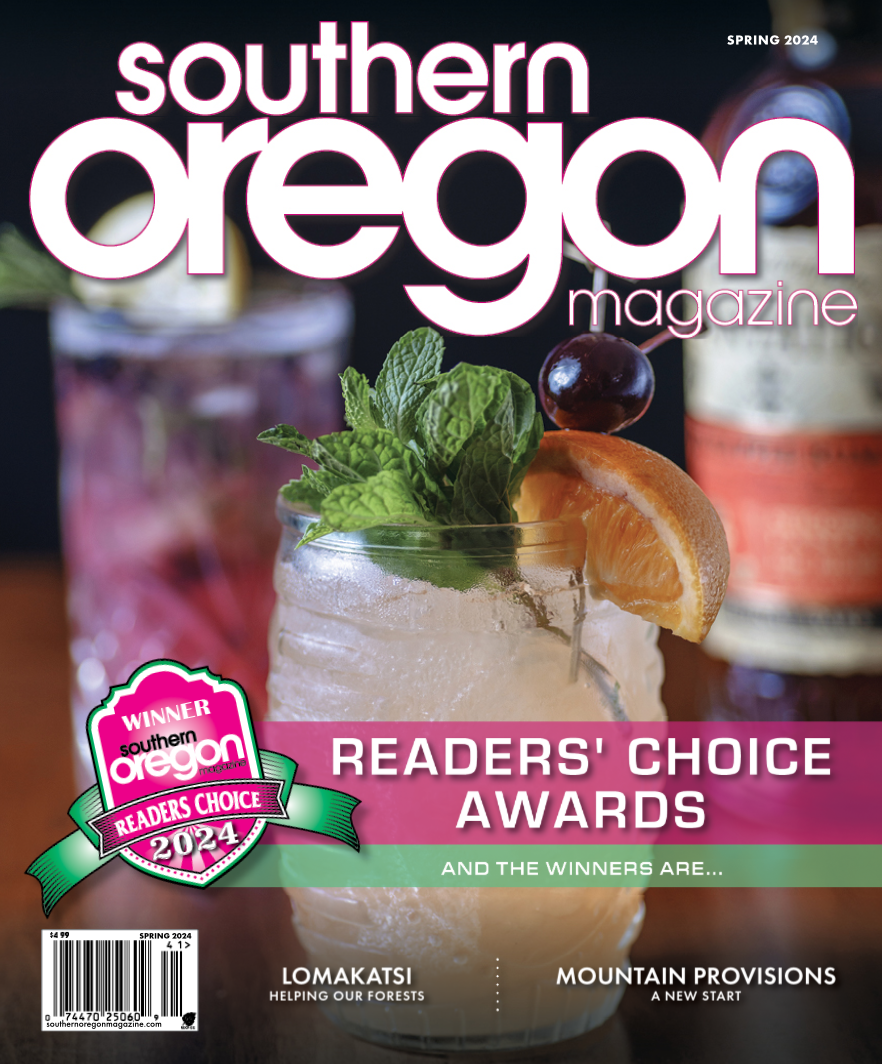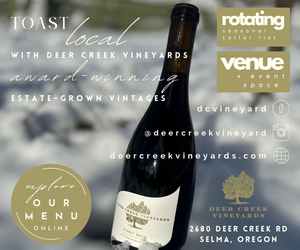

 Spring '24 Issue - Best Of Winners Announced & More
Spring '24 Issue - Best Of Winners Announced & More 
Friday, February 8, 2019
Neuman’s own wine steward—Jennifer Williamson
Somm
Neuman’s own wine steward—Jennifer Williamson
Story by Lisa Manyon
Photography by Jerry Clarkson
One of the many charms and amenities that drew me to Southern Oregon is the thriving wine industry. The allure of wine attracts new residents, tourists, and is enjoyed by locals, too.
Southern Oregon is home to five wine regions, over 150 wineries, and 70 grape varietals.
When you dine at Neuman Hotel Group restaurants, including Larks Ashland, Larks Medford, or Luna Café at Ashland Hills, you’ll enjoy farm to table and vine to glass pairings. Their entire wine program is nearly 80 percent Oregon wines, and about 40 percent of all wines available are from Southern Oregon. With so many options, it’s helpful to have expert guidance when choosing the experiences that best match your palate and personality.
While many have a passion for wine and few turn that passion into a career, for the first time, Neuman Hotel Group employs a Certified Sommelier. The Group crafts an employee development plan for each staff member, taking the interests of their employees to heart, and even helping fund education. As a part of this plan, Jennifer Williamson, Restaurant Manager and Sommelier of Larks Home Kitchen Cuisine in Ashland, completed Level 1 Sommelier. Jennifer continued her education, completing full certification through the Court of Master Sommeliers, an international organization that offers tests throughout the United States and Canada.
The definition of a sommelier is a wine steward, a definition that barely scratches the surface of what the designation entails. Becoming a sommelier is a true labor of love. The first step of certification through Court of Master Sommeliers is passing the introductory course, a prerequisite for all other levels. After that, you must pass the next test within three years of the introductory course to become Level 1 Certified. If you don’t take and pass the test within this timeframe, you must start over. The test includes three components—blind tasting, written theory and the service demonstration. From there you’re eligible to test for the Advanced Certification, Level 2. This is a three-day course, requiring you to pass the same three components as Certified, but at a more advanced difficulty level.
Jennifer took the advanced test and passed on her first try. This is quite an accomplishment, as many have to take the test multiple times. Some never pass. Jennifer shared that the testing isn’t only about wine. Participants must also be able to answer questions about craft cocktails and ask the appropriate questions to ensure cocktails are made to specification.
There is another level, Master Somm, and this title is the highest certification in wine service. There are only 273 total in the world. In America there are 182 (153 are men and 29 are women). The process of becoming a Master Somm is said to be one of the hardest tests in the world, as was documented in the movie Somm.
I had the pleasure of connecting with Jennifer to learn more about her sommelier certification and her passion for wine.
LM:When did you get certified?
JW: Certification is a two-step process through the Court of Master Sommeliers. I completed my introductory two-day course and successfully passed the introductory test in Victoria, B.C. in July 2016. I then passed the certified level test in San Jose, CA in December 2017. I was lucky to have the support of Neuman Hotel Group to help finance the expense and give me the time needed to study. Continual learning and innovation are core values of NHG, and I am very appreciative for a supportive company that values the education and empowerment of their team. Leading the team at Larks in blind tastings was a huge component of my own study process. Teaching others is a great way to learn!
I’d also like to mention that there's another organization called the Wine and Spirits Education Trust (WSET), which offers similar certifications and is the track a person would follow to become a Master of Wine. Bree Boskov, Education Manager for the Oregon Wine Board, is an example of someone who holds this certification, which is the equivalent to the Master Sommelier. WSET is more focused on the business aspect of wine including retail, wholesale, and learning to describe wine in writing. Whereas the Court of Masters is focused pretty exclusively on selling wine in a restaurant setting, and learning to identify wine varietal, region, and vintage through blind tasting. People can choose either track to get a similar educational experience, but usually Court certified somms are working in restaurants. I also hold my WSET Level 2 certification and am considering taking the Level 3 test sometime soon. I used the WSET 2 exam to study for my Certified Somm exam and now that I have passed both, I'd like to round out my wine knowledge (and writing skills) with the WSET Level 3 curriculum. It's good to keep studying and tasting in order to stay current in a dynamic field like wine and beverage.
LM:Do you have a goal to become a Master Sommelier?
JW:Not at this time, I would need to start studying for my Advanced level and that would be an enormous commitment of time. I do have other plans to travel to some amazing wine regions, and will complete Wine and Spirits Education Trust level 3.
LM: How many women hold the same certification as you? In Oregon? In the United States?
JW:Good question! There aren't any official stats beyond the Master level, but I think around 8,000 people worldwide—maybe 1/3 are women? I don't know of any other Somm (male or female) in Southern Oregon who is certified through the Court of Masters. I do know there are quite a few who have attempted the introductory course. It's much more common in Portland restaurants to have a Sommelier on the team.
LM: What drew you to a career in wine?
JW: I got into beverages through tea. The first restaurant I managed was a teahouse in Washington, D.C. called Teaism. I started learning about tea processing and how it affects the flavors in your cup. From different plant varieties to harvest time to fermentation, there are myriad ways tea producers can affect the final product. The transition from tea to wine seemed really natural to me. I always loved wine, but I didn’t think about working with wine until I started to understand the connection between food and wine, and the ability of wine to elevate a meal to an even more delicious level! That was what drove me to the sommelier path.
LM:What is your commitment to Southern Oregon Wine in relation to your position at Neuman Hotel Group?
JW: The very premise behind the restaurant is farm-to-table, so our commitment to Oregon wine is the cornerstone of our wine program, and wherever possible we include specifically Southern Oregon producers in that mix. The phrase “what grows together goes together” holds true. We find that a lot of the local foods pair excellently with wines from the region. It’s been exciting to see and contribute to the development of this wine region as we’ve continued to learn and grow together. The wines produced here continue to improve every vintage.
LM: What new developments are you keeping your eye on?
JW:I’m excited about the biodynamic scene, and there are some sparkling projects, notably Domaine Jussiaume from Jean-Michel Jussiaume, that I want to watch develop. And finally, I’m really excited about what Southern Oregon can do with the Tempranillo variety. I think we have a lot of potential with that grape here.
LM:What’s your favorite thing about wine?
JW:There’s something out there for everyone and every palate. And there’s something out there that will pair with whatever you are eating. Pairing is really fun and exciting, and can take your dining experience to the next level. It's also a great way to cultivate your sense of smell and taste. We use our eyes and ears all the time, but tend to neglect the other senses we are blessed to have. Wine can take you out of your head and help you get in touch with your senses—in moderation, of course!
LM: Favorite wine or flight at Larks Ashland, Larks Medford, and Luna Café in Ashland?
JW:At the Ashland location, I really love the Gamay Noir from Brickhouse. The elevated acidity and rustic flavors pair really well with the menu. In Medford, the Epitome of Three red blend from Ledger David has been the best-selling wine at that location since they opened! We carry Jaxon’s Tempranillo at all three restaurants. It has universal appeal and works with all our menus at a great price point.
Jennifer’s passion and knowledge of wine shines brightly and I look forward to trying more of her expert recommendations. We had the opportunity to sample the Abacela Albariño, which was delightful. We also enjoyed a special tasting of the latest, limited production release of Domaine Jussiaume sparkling wine with Jean-Michel Jussiaume. These bubbles were crafted with Chardonnay grapes, aged in stainless steel, hand riddled and racked, with only 1,000 bottles available. After sampling it, it’s clear why Jennifer is excited about this development in the local wine scene. She noted aromas of brioche, tart lemon, green apple, super crisp, buttered toast, with soft waxy finish.
For those who want to explore the Rogue Valley AVA’s (American Viticultural Area), there are multiple stay and play packages available from Neuman Hotel Group at Ashland Springs Hotel, Lithia Springs Resort, Ashland Hills Hotel and Suites, Inn at The Commons, and Nunan Estate.
Events & Promotions
Apr
26
Apr
27
Apr
28
Central Point
Charlee Prayers & The Double Dares play Rellik
Charlee Prayers & The Double Dares play Rellik
Apr
29
May
03
Gold Hill
Del Rio Vineyard Dinner in the Vineyard Spring edition OREGON FEAST
Let's celebrate Oregon Wine Month. Join us for an evening of wine ...











